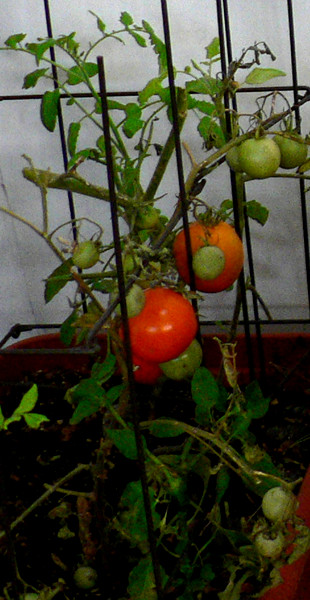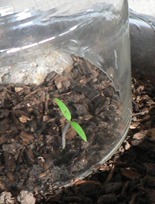
12/15/2013 ~ The tomatoes I brought in from outside looked good for awhile, but have not thrived. In fact, the leaves have wilted till there are barely any left. The small buds have not turned into flowers.
I’ve ordered seeds of a tomato (Tomato Lizzano) that was pictured growing under the eave of a house, or at least that’s what it looked like. Its leaves were a paler green the way that leaves often are when they get less light.
The thing is, I can’t really tell if my tomato is languishing for lack of light, or … lack of sufficient heat.
When I moved the planter closer to a candle, some of the leaves seemed to become more turgid, less wilted.
I was about to plant the newly arrived tomato seeds, when I began to wonder whether fortified soil, richer soil, would enable the tomatoes to “thrive” in colder temperatures.
I began wondering this because I had huge difficulty getting my yogurt to culture this month. I ran out of milk toward the end of last month, so I didn’t have a quarter jar of saved yogurt to assist the probiotic capsule. I had thought the capsule would be fine on its own, as it was in the beginning. But… No.
I wondered whether the yogurt problem was using the cheaper Bob’s Red Mill nonfat dry milk, in addition to Organic Valley powdered milk. I was rather keen to blame the milk.
But, yesterday I got yogurt. It took two days to get yogurt from the probiotic capsule, whereas once I have starter from “yesterday’s yogurt”, the yogurt begins to culture much more quickly.
Based on my observation that yogurt cultures less well in colder weather, given that my house is a LOT colder, but does culture if it has a rich starter as well as a probiotic capsule, I decided to see if tomatoes were somewhat the same. I wondered it tomatoes would do better, despite the lack of direct sunlight, if I gave them richer soil.
[amazon-product alink=”0000FF” bordercolor=”000000″ height=”240″]B000E7MTT4[/amazon-product]To that end I ordered Rock Dust, which appears to be marketed under the name Azomite.
I’d seen a video on YouTube about a garden that used wood chips and rock dust. Vegetables growing there were huge in size and reportedly very tasty.
I’d ordered “fertilizer sticks” when I ordered the tomato seeds, but now am thinking that the rock dust is a better choice. I remember reading in Secrets of the Soil, about rock dust benefiting gardens, to an almost unbelievable extent.
My Azomite will arrive on Wednesday, or Thursday, I forget. Then I can mix it with composted mulch that I have, and plant the tomatoes.
I am SO hoping this works!!!!
12/18/2013 ~ The Azomite has arrived. I’ve mixed it with composted mulch, some previously planted soil from another container, and Mycorrhizae.
Because the composted mulch was very dry I watered the soil with warm water prior to planting 3 tomato seeds.
The seed packet says the Lizzano tomato seeds originate in England, so… maybe the tomatoes will be happier with a lot less light. I say that because when I lived in London, the sun coming out and shining brightly was cause for celebration. It was not an everyday, ordinary happening.

I’m VERY hopeful. (Except, the seed packet said that the temperature for germination is 70*. With that kind of warmth the tomatoes are likely to germinate in 7-10 days. Sigh… I wonder when mine will germinate.)

1/9/2014 ~ The tomato seedling that emerged above ground on 1/1/2014, is increasing in size, whereas the squash seedlings in the pot next to the tomato, are not growing.
I wonder if this means that the tomato likes the heat from having its pot set above a large pot of water kept warm by a candle, and, given the heat it’s getting, the tomato is content with less light than that lavished on the squash seedlings.
Note ~ Months passed. The tomato seedling didn’t develop into an actual tomato plant. When the weather got warmer the seedling didn’t grow, as if it were stunted by the months with insufficient heat and light.
